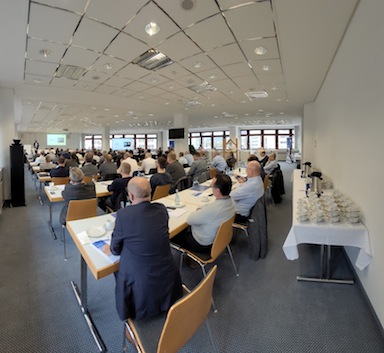
AN EXCITING look at current trends and innovative processing methods — at this year’s Leitz Symposium in Oberkochen, the focus was on topics relating to modern timber construction. Renowned speakers from industry and science presented new trends and processing methods to over 120 guests, some of which are already changing, simplifying and above all improving the world of tomorrow. For years, the Leitz Symposium has developed to become an important information forum and industry get-together for experts from industry and trade.
Strategic timber resource management, circular timber construction and roots — even a brief glance at the programme showed how creative, modern and sometimes also provocative the event was. Wood as a renewable construction material is becoming increasingly important and has developed into an innovative and highly attractive material. Now it is important to use the opportunities of modern timber construction and to draw more attention to it. A total of eight speakers presented possible solutions, current projects, development trends, machine concepts as well as tools and machining strategies at the Leitz Symposium.
Prof. Katja Frühwald-König from the Ostwestfalen-Lippe University of Applied Sciences was the first to speak. It is quite clear for her that wood is the building material of the future. But not the way it is currently used. According to Prof. Frühwald-König, timber construction must become more material-efficient. For wood as a raw material is not infinite. Due to climate change, it is necessary to reforest the domestic forests. Research on particularly climate-resistant wood species has therefore gained enormous importance.
Christian Straubinger from Taglieber Holzbau went in a similar direction with his slightly provocative presentation title “Species-appropriate human husbandry”. For the experienced engineer, the use of wood is essential for environmental protection. For, in contrast to the climate killer cement, wood is not a disposable product. It actively contributes to the thermal insulation and energy efficiency of a building. This makes building materials such as foams unnecessary. According to Christian Straubinger, the enveloping surface of buildings plays a decisive role in people’s well-being. In wooden buildings, people have a different sense of temperature and a more emotional connection to the building — in other words, a much more “species-appropriate” life.
The entrepreneur Markus Derix gave an introduction to circular timber construction. This is a circular economy in which certain building elements made of wood are given a second life. These are not thrown away after use, but are converted for further uses within existing or new buildings. This is not only a revolution in timber construction, but is also extremely resource-friendly. Prof. Dr. Jürgen Graf from the Technical University of Kaiserslautern was the next speaker providing a possible answer as to how the construction and dismantling of these building elements can be carried out smoothly. According to him, a simple connection technology between the components is elementary for a circularly effective construction method. In the research with his team, Jürgen Graf relies on a reversible connection with so-called cone adapters made of pressed synthetic resin wood. The symposium host also had a hand in this project. Leitz has developed a special cutter for the millimetre-precise cone milling, which shortens the machining process by a factor of ten compared to conventional routers.
Prof. Dr. Christina Jeschke from Biberach University of Applied Sciences explained what the buildings of the future might look like from the outside, whether built with wood, cork, plaster, fibre cement, metal or glass. Using numerous examples, the professor presented everything that is possible in façade design in modern timber construction and which materials can be used. For her, a change in thinking is already necessary in the training of young architects and designers so that sustainability aspects such as circularly effective materials management are directly taken into account. However, she also pointed out that the weathering of wood can be a challenge in construction and therefore it must be planned for that the wood will change visually over time.
Luciano Tagliaferri from the Italian machine manufacturer SCM and Andreas Kisselbach, head of the R&D department at Leitz and moderator of the symposium, then introduced the technical basics of modern timber construction. The aim is to eliminate the need for reworking the individual building elements on the construction sites. This is made possible, for example, by modern machine concepts for six-sided machining of the components and building elements. Leitz supplies the specialised matching tools. There is now much more to sawing, cutting and drilling in timber construction than there was a few years ago. For example, it is about complex five-axis machining, high-precision drilling in a short time and modern cutting strategies. These are all challenges for which the company from Oberkochen, Leitz, develops innovative solutions year after year.
At the end of the symposium, Oliver Fried from Rubner Holzbau caused quite a stir. He mentally transported the guests to Hamburg and presented the so-called “Roots” — Germany’s tallest wooden high-rise building, which is currently still under construction. Twenty storeys will later be distributed over a height of 72 metres. The completion of this architectural masterpiece in Hamburg’s Hafen City is planned for 2024 and will serve as a flagship project for modern timber construction in the future.
Jürgen Köppel, spokesman of the management board, was enthusiastic at the end of the symposium. For him it is clear that wood is the building material of the future, which has already begun today. Thus, modern timber construction and its sustainability aspects are without alternative. However, designers and architects must learn to think terms of wood as early as the training stage.
Enthusiastic guests, enthusiastic speakers and a topic that no one will be able to avoid in the future. The Leitz symposium showed: whether it’s saving CO2, creating a positive living experience, or reusing resources, making a difference not only requires long-term goals, it also requires timely action.
For contact details, see page 26 of our June/July 2023 issue on our Back Issues page.

